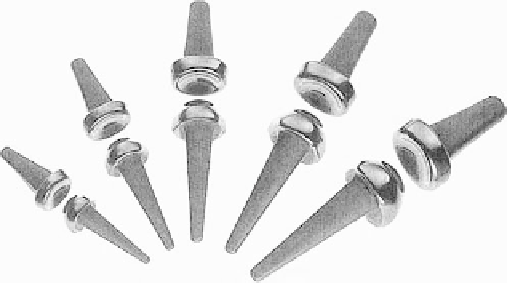Biomedical Engineering Reference
In-Depth Information
allows designers to utilize hydrodynamically efficient
shapes such as flared inlets and to incorporate external
stiffening bands that eliminate the need for a metallic
stiffening ring. The increased strain-to-failure of On-X
carbon has been used to advantage in the On-X me-
chanical heart valve design (Ely
et al.,
1998).
Cleaning and surface chemistry
Pyrolytic carbon surface chemistry is important because
the manufacturing and cleaning operations to which
a component is subjected can change and redefine the
surface that is presented to the blood. Oxidation of
carbon surfaces can produce surface contamination that
detracts from blood compatibility (LaGrange
et al.
,
1969; Bokros
et al.
, 1969). Historically, the initial ex-
aminations of pyrolytic carbon biocompatibility assumed
de facto that the surface needed to be treated with
a thromboresistant agent such as heparin (Bokros
et al.
,
1969). It was found, however, that the non-heparin-
coated surface was actually more blood compatible than
the treated surface. Hence, the efforts toward surface
coating with heparin were abandoned.
In general it is desired to minimize the surface
oxygen and any other non-carbon surface contaminants.
From XPS analyses, a typical heart valve component
surface has 76-86% C, 12-21% O, 0-2% Si, and 1-2%
Al (More and Haubold, 1996; King
et al.
, 1981; Smith
and Black, 1984). Polishing compounds tend to contain
alumina and some alumina particles may become
imbedded in the carbon surface. Other contaminants that
may be introduced at low levels
<
2% each are Na, B, Cl, S,
Mg, Ca, Zn, and N. The XPS carbon 1s peak when scanned
at high resolution can be deconvoluted to determine
carbon oxidations states. The carbon 1s peak will typically
consist primarily of hydrocarbon-like carbon (60-81%),
ether alcohol/ester-like carbon (10-24%), ketone-like
carbon (0-6%), and ester/acid-like carbon (1-12%)
(More and Haubold, 1996). Each manufacturing, cleaning
and sterilizing operation potentially redefines the surface.
The effect of modified surface chemistry on blood com-
patibility is not well characterized, so this adds a level of
uncontrolled variability when considering the blood
compatibility of pyrolytic-carbon heart-valve materials
from different manufacturing sources and different in-
vestigators. In general, the presence of oxygen and surface
contaminants should be eliminated.
Fig. 3.2.11-10 Replacement metacarpophalangeal total joint
prosthesis components, Ascension Orthopedics, Austin TX.
components were selected and matched for assembly using
the data generated from the final dimensional inspection
to achieve the dimensional requirements specified in the
device design. In
Fig. 3.2.11-10
, the pyrolytic carbon
components for a replacement metacarpophalangeal total
joint prosthesis are shown.
Assembly
The multiple components of a mechanical heart must be
assembled. The brittleness of pyrolytic carbon poses
a significant assembly problem. Because the strain-to-
failure is on the order of 1.28-1.58%, there is a limited
range of deformation that can be applied in order to
achieve a proper fit. Relative fit between the components
defines the capture and the range of motion for compo-
nents that move to actuate valve opening and closing.
Furthermore, component obstructive bulk and tolerance
gaps are critical to hemodynamic performance.
In designs that use a metallic orifice, the metallic
components are typically deformed in order to insert the
pyrolytic carbon occluder disk. For the all-carbon
bileaflet designs, the carbon orifice must be deflected in
order to insert the leaflets. As the valve diameter de-
creases and as the section modulus of the orifice design
increases, the orifice stiffness increases. The possibility
of damage or fracture during assembly was a limiting
factor in early orifice design. For this reason, the orifices
in valve designs using silicon-alloyed pyrolytic carbon
were simple cylindrical geometries, and the smallest sizes
limited to the equivalent of a 19-mm-diameter tissue
annulus. The simple cylindrical orifice designs are often
reinforced with a metallic stiffening ring that is shrunk on
after assembly. The stiffening ring ensures that physio-
logical loading will not produce deflections that can in-
hibit valve action or result in leaflet escape.
The increased strain-to-failure of pure pyrolytic
carbon, relative to the silicon-alloyed carbon, allows de-
signs with more complex orifice section moduli. This
Biocompatibility of pyrolytic carbon
The suitability of a material for use in an implant is
a complex issue. Biocompatibility testing is not the focus
of this section. In the case of pyrolytic carbon, its







